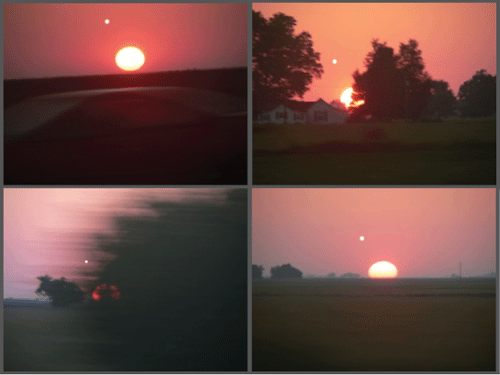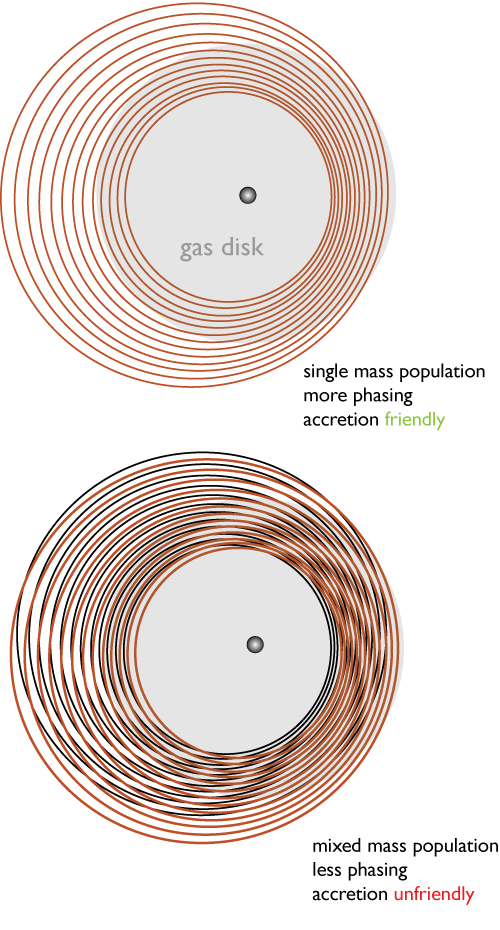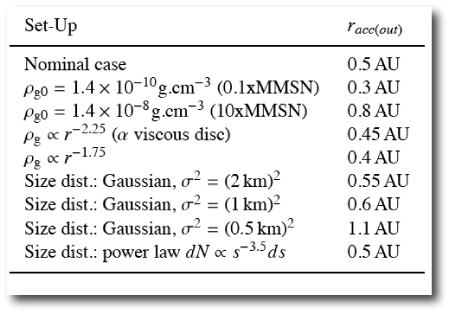
Anybody who knows anything about candy knows that “fun size” isn’t any fun at all. The same is true for terrestrial planets. Fun size objects like Mercury, the Moon, Ceres, Vesta and Pallas are airless cratered and dead.
For the past several years, I’ve been agitating for a dedicated radial velocity search for potentially habitable King-size terrestrial planets in the Alpha Centauri system. A number of factors (brightness, age, spectral type, metallicity, orientation, and sky position) make Alpha Cen B overwhelmingly best star in the sky for detecting habitable planets from the ground and on the cheap.
Planets are dynamically stable in the habitable zone of Alpha Cen B. It’s also true that if one starts with hundreds of lunar-sized embryos in the Alpha Cen system, then the formation of King-size terrestrial planets is effectively a given.
But there’s a snag. Those embryos may never have formed. Recent work by Philippe Thebault and his collaborators makes a case that the Alpha Centauri system provided an unfavorable environment for the accretion of planetary embryos, and as a result, the prospects for finding a habitable planet right next door may be depressingly slim. Thebault et al’s first paper (here) clears out the planets around A, and their second paper, which came out at the beginning of this month (here), deals effectively with B.
The basic idea works like this. During the epoch when kilometer-sized bodies are trying to accrete and grow, the presence of a binary stellar perturber forces planetesimal orbits in the circumprimary disks to be eccentric. This eccentricity forcing occurs in the presence of gas drag on the planetesimals. For a population of equal-mass bodies, gas drag and gravitational forcing cause the periastra of the planetesimal orbits to line up. When such phasing occurs, neighboring particles have small relative velocities, collisions are gentle, and the planetesimals are able to grow via collisional agglomeration.
Unfortunately, both the forced eccentricity and the phase angle relative to the binary periastron depend on planetesimal mass. If the disk contains bodies of different sizes, then one gets crossing orbits and larger collision velocities. Planetesimals don’t stick together when they’re bashed together.

Thebault and his collaborators sum up their bottom line results in the following table (which I’ve clipped directly out of their Alpha Cen B paper):

The column on the left lists the initial conditions. The column on the right gives the radius beyond which construction of embryos is thwarted. Conditions that are consistent with the disk that gave rise to our Solar System are encapsulated in the “minimum-mass solar nebula” (MMSN) nominal case. When the MMSN is used as an initial condition for Alpha Cen B, the region exterior to 0.5 AU is unfriendly to accretion. In order for embryos to form in the habitable zone, one’s best bet is to crank up the disk gas density by a factor of at least several. (The table indicates that a 10xMMSN initial conditions allows embryos to form all the way out to 0.8 AU).
Even when confronted with these results, I’m still cautiously long Alpha Cen Bb. It’s not that I think the simulations are wrong or that there is any problem with the outcomes that they produce. Rather, I don’t think a high gas density in the inner AU of the Alpha Cen B disk is cause for alarm. In a nutshell, I don’t see evidence that the MMSN is of any particular utility for explaining the extrasolar planetary systems that we’ve found so far, and hence I’m not depressed that high gas densities were required for Alpha Cen B to have fostered an accretion-friendly environment. Reconstitute, for example, the HD 69830 protoplanetary disk or the 55 Cnc protoplanetary disk. I’m plain skeptical of the validity of a fiducial MMSN scaling for the disks that orbited the Alpha Cen stars. The Alpha Cen binary has twice the total mass of the Solar System, and more than two thousand times the total angular momentum.
We need to do the experiment and find out what’s really there.

Aargh my comment got eaten!
Basically pointed out arXiv 0811.0868 in regard to modelling 55 Cancri’s protoplanetary disc, which presents quite an interesting scenario.
Two questions:
1) What do you think the odds now are of there being a planet somewhere in the Alpha Centauri system?
2) How long will it be before we can confirm that there are no such planets through direct observation, if they don’t exist?
I understand it’s all speculation, but I am curious what the experts think as the evidence (one way or the other) accumulates.
Very interesting picture! I’ve often contemplating seeing something very similar when I gaze out at the sun during sunrise.
With the recent direct imaging successes with Hubble, what are the chances of catching planets around the nearest star.
Admittedly this is not a young system putting out Infrared radiation but the proximity calls out for an attempt.
Is this at all worth while?
TheoA, Greg most likely can give you a better answer, but I’m going to venture at a “not likely”.
Fom b is a very young planet, probably surrounded by a moon-forming circumplanetary disk, making it much easier to detected if it were otherwise. Also, Fom b has a semi-major axis of 119 AU — pretty far from Fomalhaut itself.
HR 8799 and company were detected in infrared. This is feasible as they are very young and still glow with the heat of their formation.
Alf Cen, on the other hand, is a mature, binary system. The semi-major axes of the Alf Cen stars is ~30 AU if I recall correctly, so any planets should be significantly closer to either star than Fom b is to Fomalhaut, or HR 8799 b, c, or d, are to their host.
Thanks for the questions —
1) What do you think the odds now are of there being a planet somewhere in the Alpha Centauri system?
Hazarding a guess, I’d say 60%. A better answer might be, “High enough to warrant mounting an inexpensive (in comparison to most other planet-search efforts in operation or contemplation) ground-based search.”
2) How long will it be before we can confirm that there are no such planets through direct observation, if they don’t exist?
Assuming that the Alpha Cen B continues to cooperate with the radial velocity observers, we’ll know in five years whether there are any planets in the system that are Earth-mass or above. In three years, we’ll have an very good indication of what’s going on.
3) With the recent direct imaging successes with Hubble, what are the chances of catching planets around the nearest star.
We know that there aren’t any circumprimary Jovian-mass planets in the Alpha Cen system, and the system is ~7 billion years old, so direct imaging with Hubble isn’t an option. RV is the only near-term option.
To sum up, exciting times await us all with the new missions to come!
Thanks for taking the time to answer my questions, Greg. Here’s to hoping you’re right and we do find something next door.
Pingback: Centauri Dreams » Blog Archive » Notes & Queries 11/24/08
Pingback: Populär Astronomi - » Planetjägarna möter allmänheten i Göteborg och Stockholm
Pingback: Centauri Dreams » Blog Archive » Centauri Planets: Year-End Thoughts